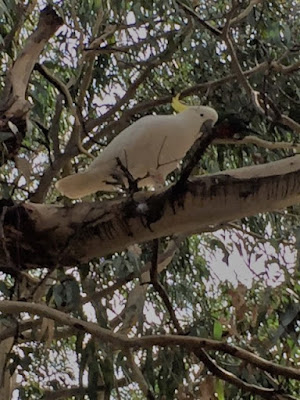The pick up was at 7:15am in front of St. Paul's Cathedral. A mini bus carried 20 some passengers from different places. We were able to take seats on the left hand side of the bus so that we may enjoy the views fully. It was Wendy's suggestion.
We passed through West Gate Bridge with a high elevation, which allowed us to have a panoramic view of the City of Melbourne on the right and Yarra River on the left connecting to Williams Town.
The first stop was at Torquay, a beach town and also called the surfing capital. One of the global surfing gear manufacturers is located in this town and hosting various surfing events. There was a sign for Surf Museum. Technically, Torquay is the starting point of the Great Ocean Road that stretches over 300 km. We were served morning tea with cookies and biscuits .This town has 2,000 inhabitants who are mostly part time residents and people on holidays from Melbourne.
We passed through Anglesea Beach that is known to have a lot of birds including Cockatoos, white Australian bird. Also, Koalas can be spotted. We passed through a light house that was supposed to have been built at an inappropriate location. After this light house was the longest sand beach with bigger waves spotted.
We stopped for taking a photo at an arch sign of the Great Ocean Road.
We enjoyed the most scenic route from the sign along the winding roads. You could spot many wild land and sea animals on this route.
We stopped over at Kennett River. It was the place where you can spot Koalas on the Eucalyptus trees on the hill side. We were able to spot three Koalas, but they were too far to take any meaningful photos. Koala's main food is the leaves of only 10 species of Eucalyptus trees out of 700 species. Many trees die because too many Koalas eat up the tree leaves. One Koala needs 20-30 trees for their meals. Koalas can be quite noisy when male Koalas declare their territories with grunting sounds. Their sounds can reach as far as 1 km.
We arrived at the famous Apollo Bay, a tourist town. It is known to be the beach that is the most suitable for swimming. We had a lunch break here. The restaurant was like a zoo or a food factory with so many groups stopping over, but I managed to enjoy a cone of ice cream purchased from Dooley's Ice Cream parlor.
After lunch, we stopped over at a Rain Forest called Mait's Rest for a 30 minute walk. We saw several giant eucalyptus trees some of which were 300 year old and others of 2-3 meters in diameter. What was amazing was that they could grow even taller. We also saw 5-meter tall ferns.
The highlight of the Great Ocean Road is 12 Apostles. They used to be called 12 piglets, but the name was changed to the current name in 1940 to appeal to tourists. Obviously, the name change has been successful. Annually, this iconic site is attracting 2.0 million tourists. As the name indicates, it used to have 12 rock formations of soft lime stones, but the rain made initial cracks on the rocks eroded by the Southern Ocean's harsh winds and strong currents. As a result, 2 of them have collapsed with now only 10 standing. Out of 10 remaining, even 3 are hidden and not visible. Helicopter tour was available to see them all, but the cost was far too expensive. The water was breaking in white wakes on a long stretch of the beaches. It was breath-takingly beautiful.
Another landmark in the area was Loch Ard Gorge where many ships wrecked due to the strong winds and currents. The total number of ships wrecked was estimated at 700. At this particular location, there was one shipwreck that took place in 1838. The ship's name was Loch Ard that had 54 people on board. After the ship wrecked, only 2 survived: namely Tom and Eva. Tom was an intern sailor who survived first and saved Eva who was 18 years of age. Tom stayed as a sailor and is said to have survived a total of 4 shipwrecks. What a life! But, Eva, after the rescue, flew back to Ireland and never came back. Gibsen, a sheep ranch farmer nearby, helped them out in their rescue. Tom climbed up the gorge and asked for help.
Gibsen's Steps was located nearby and we were able to get down to the beach through Gibsen's steps to see the sunset. Gibsen, the farmer who rescued Tom and Eva, built the steps to help people walk down from the top of the cliff to the beach, a height of approximately 70 meters. We saw a gorgeous sunset view from the beach with the rough water coming from Antartica as the backdrop.
On the way back, the bus came through highways so no view was available. It was okay because it was dark outside anyway. A long day with a long tour of 14 hours. We were picked up at at 7:15am and dropped off at 9:15pm. Simon was the driver and tour guide, and he was excellent, professional and knowledgeable. It was an unforgettable experience. - Jeffrey












































No comments:
Post a Comment